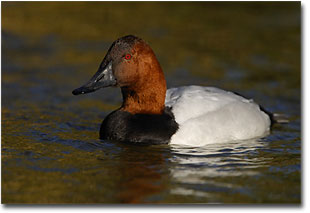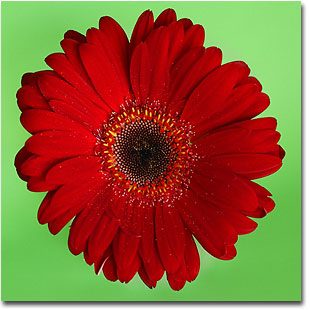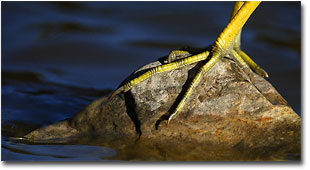|
|
 Camera Equipment Review... Nature Photography and the Canon EOS 1D
Text and photography Copyright E.J. Peiker Much has been written about how the Canon EOS 1D is aimed squarely at photojournalists and does not address the needs of the nature photographer. Well, after a few weeks of owning the 1D and putting it through its paces, I am happy to report that this is just not the case and am ready to retire my EOS 1v to a backup role. Lets examine the facts. The EOS 1D is basically an EOS 1v with a 4.48 Mega-pixel digital back. The 1D retains all of the qualities of the 1v including a super fast frame rate at 8.3 FPS (Canon claims 8 FPS but several independent test labs have confirmed it to actually be 8.3 FPS), the excellent AF system, the Canon evaluative metering system, ETTL flash, 45 point active Auto-focusing, and of course compatibility with the excellent line of Canon EF lenses including lenses with image stabilization at every focal length from 28mm to 600mm.
An additional advantage of the slightly smaller frame size is that the AF sensor covers a larger portion of the frame. The 1D uses an identically sized AF sensor array as in the 1v, thereby covering more of the smaller frame in the 1D. This makes it easier to follow focus with fast moving action as a larger percentage of the viewfinder has AF sensors. It also results in fewer times when you have to recompose after locking focus on the subject of interest as there is a higher probability that one of the sensors falls on the area you wish to focus on. Switching from the EOS 1v to the EOS 1D is relatively simple as the basic photography controls are identical and do not need to be relearned. For those new to the EOS system, the manual is very well written and easy to understand, although the index is very sparse making it difficult at times to find what you are looking for. For the 1v convert, the only thing that need be learned are the digital controls which are very simple to use and fully menu driven via the 2-inch LCD monitor on the back of the camera and the software interface that must be installed on your PC. Software installation and use is a snap but be aware your computer needs to have an IEEE 1394 Firewire connection. Only the newest PCís have this so you may need a Firewire card. These are easy to get at any computer supply house and are inexpensive (I paid $49.00 for a top name-brand one). For Laptop users, PCMCIA cards with two Firewire ports are also available and relatively affordable. All of the communication back and forth between your PC and the camera is done via the 1394 interface. This includes setting the many Personal functions to make the camera behave exactly as you want. Pictures can be transferred directly off of the Compact Flash or Microdrive to your PC through this connection as well. You can also transfer them through a Compact Flash card reader. Overall the start-up experience is very easy. As mentioned above, the suitability of the EOS 1D as a Nature Camera has been called into question. One of the reasons for this is the 4.1 mega-pixel raw image size that it produces compared to the slightly larger pixel-size of competitive cameras. The 1D produces a 10 x 6.67 image on an Epson printer (at the Epson recommended 240DPI) with no interpolation - to get a standard 12x8 (or cropped 10x8), only a small amount of interpolation is needed and the images are of impeccable quality. Even at the larger 18x12 size using either a stair-step interpolation or Genuine Fractals upsizing, the images are equal or better in quality to a good scan off of a film scanner. My conclusion is that from a resolution standpoint, the EOS 1D is more than good enough for a 2-page magazine spread. Of course a higher pixel count would be nice but it would come at the sacrifice of frame rate. I have also seen written in several publications, as well as on-line, that Nature photographers donít need 8 Frames per second and that Canon should have sacrificed frame rate for higher resolution. I disagree with this assessment due to the type of photography I do. If I were purely a landscape photographer, I would agree but I shoot lots of wildlife that is on the move - to get a good shot, a very high frame rate is sometimes imperative. The 1D will shoot 21 consecutive images in JPEG mode and 16 in RAW mode before having to flush the buffer. As soon as there is enough room for the next photograph the shutter can be tripped again - the buffer need not be completely cleared before the camera can shoot again. Finally, the 1D has been criticized for banding at high ISO settings in shadow and under-exposed areas. This is a real issue but is not noticeable below ISO 800 and even at ISO 800 unless you are producing full size images (10x6.7) or larger, it is not noticeable. The vast majority of nature photographers prefer much lower ISO settings to keep image noise (grain) low.
To test noise, I took 4 photos of blue sky at ISO 200, 400, 800, and 1600 and then compared the noise level to the equivalent ISO Fuji transparency film - Provia 100F at 200, Provia 400F, Provia 400F at ISO 800, and Provia 1600. I chose blue sky because the human eye tends to find grain in blue more objectionable than in other colors. Presumably this is due to our being conditioned to texture-less sky. The digital images were all shot in uncompressed RAW mode with no sharpening or any other processing applied, the slide films were shot at the speed listed, processed properly and then scanned at equivalent image sizes and resolution as what the 1D is capable of. In every case, the 1D image had less noise than the equivalent film had in grain. In the field, the 1D handles just like the 1v except you donít have to change film or in this case CF cards as often as a 512MB card will hold approximately 100-180 images in RAW mode depending on image complexity. During downtime, you can edit out shots that have exposure, composition, or to some degree, focus problems resulting in a higher effective capacity. Whether or not your shot was exposed properly is very easy to determine from the image histogram. You can also set the monitor to blink in areas where the image is overexposed. Composition can be judged from the LCD monitor. Focus is a little tougher to determine as the monitor is very small; however, you can turn on a feature that shows which AF selector was used to focus the image - if it is clearly in a different spot than you intended, you might determine that the image will not be sharp. With practice it becomes easier and easier to tell whether or not the image was focused properly. One concern for the nature photographer in the field is the longevity of the battery. For this review I spent a morning at a local area known for its large variety of ducks. This type of photography, as well as most bird photography, requires you to spend a lot of time with the Image Stabilization engaged and the shutter partially depressed. A full charged battery did not last as long as the 160 shots I got off of one 512MB CF card. A landscape photography shoot should yield many more photos as much less time is spent with the shutter trigger partially depressed. Having a spare battery or two handy at all times is imperative in my opinion if you are planning to shoot a lot in the field. Fortunately Canon provides a charger with the camera that you can hook two batteries to. Additionally, an AC adapter is also provided so that you can do your downloads while the batteries are charging by plugging the camera directly into a wall. This is an excellent accessory that is included. The EOS 1D is insulated well from the elements. Like the EOS 1v it shares its many waterproof gaskets. Since the 1D has its power-winder and battery compartment integrated into the camera body rather than a separate unit (aka 1v), the weatherproofing is even more complete. With the introduction of the new EF 16-35mm f/2.8L IS USM and the EF 70-200mm f/2.8L IS USM lenses, Canon now has lenses that will complete the weather tight seal at every focal length from 16-600mm with the exception of the range from 28-70mm. Can a new version of the EF 28-70mm f/2.8l IS USM with the weather gaskets be far behind? Shutter delay is indistinguishable from the EOS 1v film camera as is viewfinder blackout - this is a very responsive camera. This is critical for the action shooter. A nice addition that can be useful in the great outdoors is the addition of 1/500 sec as a flash sync speed and 1/16000 sec as the fastest exposure time. While previously you could flash objects in High Speed Sync mode at 1/500, a significant power output reduction from the flash unit was an undesirable side effect. This is now not an issue until you get to shutter speeds above 1/500 sec and will be highly valuable in outdoor fill-flash situations. All Canon EX series flash units are compatible with the 1/500 sync speed.
Overall, I have been very pleased with the EOS 1D - it clearly is a highly capable camera for the Nature Photographer. It is very responsive in the field and gives up nothing to the highly successful EOS 1v - being able to check exposure and composition real-time has led to a much higher percentage of keepers when I get home from a nature shoot. Naturally I would like a higher pixel count but not at the expense of frame rate and the other great features of this camera. Mooreís law dictates that pixel count will double every two years with everything else being equal so that means we only need to wait until late 2003 for an 8 FPS 8 mega pixel camera. Mooreís law has accurately predicted the increase in electronic circuit density for the last 35 years! This signals a major change in the camera industry. An old original Canon F1 can take a photograph of equal image quality as the state of the art Canon EOS 1v. An EOS 1z (for lack of a better name) in 2004 will far surpass the superb image quality of todayís state of the art EOS 1D. Welcome to the upgrade cycle! This stuff is fun!!! EJP - NPN 016 Comments on this article? Send them to the editor. |
|
|
 The image sensor in the 1D is slightly smaller than the standard 35mm frame resulting in a 1.3x magnification level for the equivalent focal length. This is a boon for the wildlife shooter as shots taken with a 1.4x teleconverter on a traditional 35mm camera can be taken with no teleconverter on the 1D and you donít lose the stop of light that a traditional teleconverter loses. Similarly, where you had to use a 2x teleconverter before, you can usually get away with the 1.4x now resulting in an effective 1.8x magnification factor but with only one stop of light lost instead of two. Of course on the wide angle end, this can pose a problem as the popular 24 and 28mm wide angle lenses become the 35mm equivalent of 31mm and 36mm respectively. Fortunately Canon has addressed this with the excellent new EF 16-35mm f/2.8L lens, which results in an equivalent 21mm focal length at the wide end. If you need to go even wider, there is the EF 14mm f/2.8L lens that has the equivalent focal length of 18mm on the EOS 1D - this should be wide enough for the vast majority of landscape photos.
The image sensor in the 1D is slightly smaller than the standard 35mm frame resulting in a 1.3x magnification level for the equivalent focal length. This is a boon for the wildlife shooter as shots taken with a 1.4x teleconverter on a traditional 35mm camera can be taken with no teleconverter on the 1D and you donít lose the stop of light that a traditional teleconverter loses. Similarly, where you had to use a 2x teleconverter before, you can usually get away with the 1.4x now resulting in an effective 1.8x magnification factor but with only one stop of light lost instead of two. Of course on the wide angle end, this can pose a problem as the popular 24 and 28mm wide angle lenses become the 35mm equivalent of 31mm and 36mm respectively. Fortunately Canon has addressed this with the excellent new EF 16-35mm f/2.8L lens, which results in an equivalent 21mm focal length at the wide end. If you need to go even wider, there is the EF 14mm f/2.8L lens that has the equivalent focal length of 18mm on the EOS 1D - this should be wide enough for the vast majority of landscape photos. Image quality with the 1D is excellent. Canon provides various color sensitivities from standard sRGB to a much wider gamut - Adobe-RGB(1998). There is also a color space optimized for skin tones and another one that simulates high chroma films like Fujichrome Velvia. You can customize your own color curves via Canonís software. Color temperature can be automated or manually selected. There is an option to program the camera with custom color temperature settings. Additionally, the white balance can be adjusted in 100-degree steps manually.
Image quality with the 1D is excellent. Canon provides various color sensitivities from standard sRGB to a much wider gamut - Adobe-RGB(1998). There is also a color space optimized for skin tones and another one that simulates high chroma films like Fujichrome Velvia. You can customize your own color curves via Canonís software. Color temperature can be automated or manually selected. There is an option to program the camera with custom color temperature settings. Additionally, the white balance can be adjusted in 100-degree steps manually. After a productive day of shooting with your 1D, it is time to offload the images from the Compact Flash Card or the Microdrive. As stated earlier, you can remove the media from the camera and download it to a PC or a digital wallet via a card reader or you can transfer the images directly to a computer using the IEEE 1394 interface. The latter is significantly faster. The images are brought into Canonís imaging software where many things including exposure, color space, color temperature, etc can be adjusted. From there you can either load the images to a folder on your hard-drive or load them directly into Photoshop. Photoshop 5.0LE is included with the 1D. I used the full Photoshop 6.01 version for this review. Once in Photoshop, you can do everything that this incredible program is capable of to the images to prepare them for printing, publishing, or posting on the Internet. The process is very simple and is much quicker than the old method of sorting through slides on a light-table, scanning the images and then doing the Photoshop work.
After a productive day of shooting with your 1D, it is time to offload the images from the Compact Flash Card or the Microdrive. As stated earlier, you can remove the media from the camera and download it to a PC or a digital wallet via a card reader or you can transfer the images directly to a computer using the IEEE 1394 interface. The latter is significantly faster. The images are brought into Canonís imaging software where many things including exposure, color space, color temperature, etc can be adjusted. From there you can either load the images to a folder on your hard-drive or load them directly into Photoshop. Photoshop 5.0LE is included with the 1D. I used the full Photoshop 6.01 version for this review. Once in Photoshop, you can do everything that this incredible program is capable of to the images to prepare them for printing, publishing, or posting on the Internet. The process is very simple and is much quicker than the old method of sorting through slides on a light-table, scanning the images and then doing the Photoshop work.